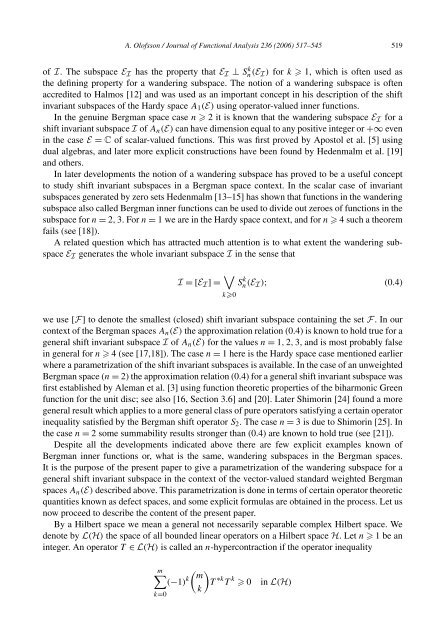Estimation optimale du gradient du semi-groupe de la chaleur sur le ...
Estimation optimale du gradient du semi-groupe de la chaleur sur le ...
Estimation optimale du gradient du semi-groupe de la chaleur sur le ...
You also want an ePaper? Increase the reach of your titles
YUMPU automatically turns print PDFs into web optimized ePapers that Google loves.
A. Olofsson / Journal of Functional Analysis 236 (2006) 517–545 519<br />
of I. The subspace EI has the property that EI ⊥ S k n (EI) for k 1, which is often used as<br />
the <strong>de</strong>fining property for a wan<strong>de</strong>ring subspace. The notion of a wan<strong>de</strong>ring subspace is often<br />
accredited to Halmos [12] and was used as an important concept in his <strong>de</strong>scription of the shift<br />
invariant subspaces of the Hardy space A1(E) using operator-valued inner functions.<br />
In the genuine Bergman space case n 2 it is known that the wan<strong>de</strong>ring subspace EI for a<br />
shift invariant subspace I of An(E) can have dimension equal to any positive integer or +∞ even<br />
in the case E = C of sca<strong>la</strong>r-valued functions. This was first proved by Apostol et al. [5] using<br />
<strong>du</strong>al algebras, and <strong>la</strong>ter more explicit constructions have been found by He<strong>de</strong>nmalm et al. [19]<br />
and others.<br />
In <strong>la</strong>ter <strong>de</strong>velopments the notion of a wan<strong>de</strong>ring subspace has proved to be a useful concept<br />
to study shift invariant subspaces in a Bergman space context. In the sca<strong>la</strong>r case of invariant<br />
subspaces generated by zero sets He<strong>de</strong>nmalm [13–15] has shown that functions in the wan<strong>de</strong>ring<br />
subspace also cal<strong>le</strong>d Bergman inner functions can be used to divi<strong>de</strong> out zeroes of functions in the<br />
subspace for n = 2, 3. For n = 1 we are in the Hardy space context, and for n 4 such a theorem<br />
fails (see [18]).<br />
A re<strong>la</strong>ted question which has attracted much attention is to what extent the wan<strong>de</strong>ring subspace<br />
EI generates the who<strong>le</strong> invariant subspace I in the sense that<br />
I =[EI]= <br />
S k n (EI); (0.4)<br />
k0<br />
we use [F] to <strong>de</strong>note the smal<strong>le</strong>st (closed) shift invariant subspace containing the set F. In our<br />
context of the Bergman spaces An(E) the approximation re<strong>la</strong>tion (0.4) is known to hold true for a<br />
general shift invariant subspace I of An(E) for the values n = 1, 2, 3, and is most probably false<br />
in general for n 4 (see [17,18]). The case n = 1 here is the Hardy space case mentioned earlier<br />
where a parametrization of the shift invariant subspaces is avai<strong>la</strong>b<strong>le</strong>. In the case of an unweighted<br />
Bergman space (n = 2) the approximation re<strong>la</strong>tion (0.4) for a general shift invariant subspace was<br />
first established by A<strong>le</strong>man et al. [3] using function theoretic properties of the biharmonic Green<br />
function for the unit disc; see also [16, Section 3.6] and [20]. Later Shimorin [24] found a more<br />
general result which applies to a more general c<strong>la</strong>ss of pure operators satisfying a certain operator<br />
inequality satisfied by the Bergman shift operator S2. The case n = 3 is <strong>du</strong>e to Shimorin [25]. In<br />
the case n = 2 some summability results stronger than (0.4) are known to hold true (see [21]).<br />
Despite all the <strong>de</strong>velopments indicated above there are few explicit examp<strong>le</strong>s known of<br />
Bergman inner functions or, what is the same, wan<strong>de</strong>ring subspaces in the Bergman spaces.<br />
It is the purpose of the present paper to give a parametrization of the wan<strong>de</strong>ring subspace for a<br />
general shift invariant subspace in the context of the vector-valued standard weighted Bergman<br />
spaces An(E) <strong>de</strong>scribed above. This parametrization is done in terms of certain operator theoretic<br />
quantities known as <strong>de</strong>fect spaces, and some explicit formu<strong>la</strong>s are obtained in the process. Let us<br />
now proceed to <strong>de</strong>scribe the content of the present paper.<br />
By a Hilbert space we mean a general not necessarily separab<strong>le</strong> comp<strong>le</strong>x Hilbert space. We<br />
<strong>de</strong>note by L(H) the space of all boun<strong>de</strong>d linear operators on a Hilbert space H. Letn 1bean<br />
integer. An operator T ∈ L(H) is cal<strong>le</strong>d an n-hypercontraction if the operator inequality<br />
m<br />
k=0<br />
(−1) k<br />
<br />
m<br />
T<br />
k<br />
∗k T k 0 inL(H)

















